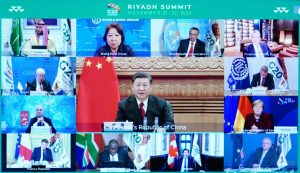By H.E. Sun Weidong

While the world is battling the COVID-19 pandemic as it goes through profound changes never seen in a century, we are facing a new critical juncture in human history. In this context, the recently concluded Fifth Plenary Session of the 19th Communist Party of China (CPC) Central Committee adopted recommendations for formulating China’s 14th Five-Year Plan (2021-2025) and the Long-Range Objectives Through the Year 2035, which not only depicted a great blueprint for China’s development in the next stage, but will also have a significant impact on the world.
Great Achievements
The 14th Five-Year Plan builds on the success of the 13th Five-Year Plan. During the 13th Five-Year Plan period (2016-2020), China has made remarkable achievements and continued to script shining examples of development. China’s GDP is expected to exceed 100 trillion yuan ($15.22 trillion), and per capita GDP has already surpassed $10,000. More than 50 million people and all 832 poor counties have been lifted out of poverty. The absolute poverty is going to be eradicated historically. China’s added value of manufacturing industry accounted for nearly 30 percent of the world’s total, ranking first in the world for 10 consecutive years. China has made a series of major breakthroughs in high-tech fields such as 5G network, Beidou Navigation Satellite System, lunar exploration and Mars exploration. The first centenary goal of building a moderately prosperous society in all respects will be realized soon, and China will embark on a new journey toward fully building a modern socialist country.
New Development Philosophy
The major characteristics of China’s development in the new era are reflected in three “new”s. First, grasp the new stage of China’s development based on a scientific analysis. Second, embrace the new development philosophy that is innovative, coordinated, green and open for the benefit of all. Third, actively foster a new development paradigm with domestic circulation as the mainstay and domestic and international circulations reinforcing each other. To be specific, the focus would be on three things — reform, openness and innovation.
First, deepen reform comprehensively. Reform is a powerful driving force for development. Thanks to the continuous efforts of reform, China’s rank jumped from 78th to 31st in the World Bank’s Doing Business Report in the past two years. In July this year, the Chinese Government proposed to support 15 new business forms, including online education, online healthcare, online office and micro economy. The digital economy currently accounts for more than 36% of China’s GDP and contributes 67.7% to GDP growth, serving as a new engine for China’s economic and social development. China will build high-level socialist market economy by comprehensively deepening the reform to stimulate the vitality of the 1.4 billion Chinese people and gradually move toward common prosperity.
Opening-up

Second, remain committed to opening up. Opening up is an inevitable choice to promote development. Since 2013, China has set up 21 pilot free trade zones, and negative lists for foreign investment have also been gradually shortened. Based on initial achievements in the fight against the COVID-19, China successfully hosted the China International Fair for Trade in Services (CIFTIS), the China Import and Export Fair (the Canton Fair) and the China International Import Expo (CIIE) this year, demonstrating China’s confidence and resolution to expand opening up at a higher starting point. No matter how the international situation changes, China will never waver in our basic national policy of opening up. China’s new economic development pattern of “dual circulation” is by no means a closed domestic loop, but a more open domestic and international dual cycle. Through pursuing high-level opening up, China will provide larger markets and more opportunities for countries around the world, which not only is conducive to China’s own development, but also helps to form a more just and reasonable global economic governance system.
Third, innovation leads to progress. Innovation is the first driving force for development. China attaches great importance to scientific research investment. In the past 5 years, the ratio of R&D expenditure to GDP has increased from 2.06% to 2.23%, and basic research expenditure has nearly doubled. According to the Global Innovation Index 2020 released by the World Intellectual Property Organization, China’s ranking has jumped from 29th in 2015 to 14th in 2020. China will turn self-reliance in science and technology into a strategic pillar for national development, strive toward the goal of developing into a science and technology power, shape all-around new development advantages, and strongly support high-quality economic development and high-quality life for the people.
China & the World

China’s development cannot be achieved without the world, and the world also needs China for its development. The more developed China is, the closer it is connected with the region and rest of the world, and the more it needs a peaceful and stable international and neighbourhood environment. Chinese President Xi Jinping recently attended several major multilateral events successively and delivered a series of important speeches. He put forth a series of important initiatives and measures, and elaborated on the implications of China’s new development paradigm, stressing that China will always be a builder of global peace, a contributor to global development and a defender of international order. He also stressed that China will uphold multilateralism, peaceful development and win-win cooperation, resolutely build a new type of international relations and a community with a shared future for mankind. His remarks demonstrate that China shoulders its responsibilities of promoting international peace and development.
China & India: Similar Challenges
As the two largest developing countries and emerging economies, China and India face similar development tasks and goals. Both countries are currently committed to fighting the COVID-19, revitalizing the economy and improving people’s livelihood. The common interests between our two countries far outweigh the differences. We should take a far-sighted view, meet each other halfway, build consensus, and join hands in development, strengthen cooperation in areas such as anti-epidemic, economic recovery, multilateralism and global governance. In this way, we could make 2.7 billion people of our two countries live a better life, and make due contributions to safeguarding world peace and stability and promoting common development.
(H.E. Sun Weidong is China’s Ambassador to India)
Author Profile
- India Writes Network (www.indiawrites.org) is an emerging think tank and a media-publishing company focused on international affairs & the India Story. Centre for Global India Insights is the research arm of India Writes Network. To subscribe to India and the World, write to editor@indiawrites.org. A venture of TGII Media Private Limited, a leading media, publishing and consultancy company, IWN has carved a niche for balanced and exhaustive reporting and analysis of international affairs. Eminent personalities, politicians, diplomats, authors, strategy gurus and news-makers have contributed to India Writes Network, as also “India and the World,” a magazine focused on global affairs.
Latest entries
 India and the WorldNovember 26, 2025G20@20: Africa’s Moment – The Once and Future World Order
India and the WorldNovember 26, 2025G20@20: Africa’s Moment – The Once and Future World Order DiplomacyOctober 4, 2025UNGA Resolution 2758 Must Not Be Distorted, One-China Principle Brooks No Challenge
DiplomacyOctober 4, 2025UNGA Resolution 2758 Must Not Be Distorted, One-China Principle Brooks No Challenge India and the WorldJuly 26, 2025MPs, diplomats laud Operation Sindoor, call for national unity to combat Pakistan-sponsored terror
India and the WorldJuly 26, 2025MPs, diplomats laud Operation Sindoor, call for national unity to combat Pakistan-sponsored terror India and the WorldJuly 25, 2025When Fire Ends, Diplomacy Begins
India and the WorldJuly 25, 2025When Fire Ends, Diplomacy Begins







